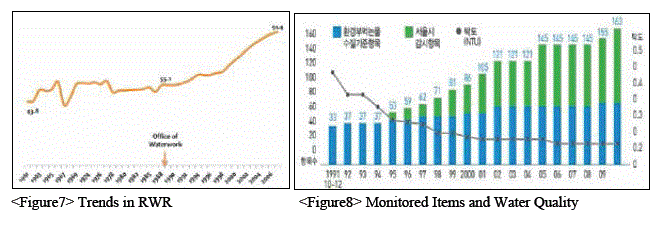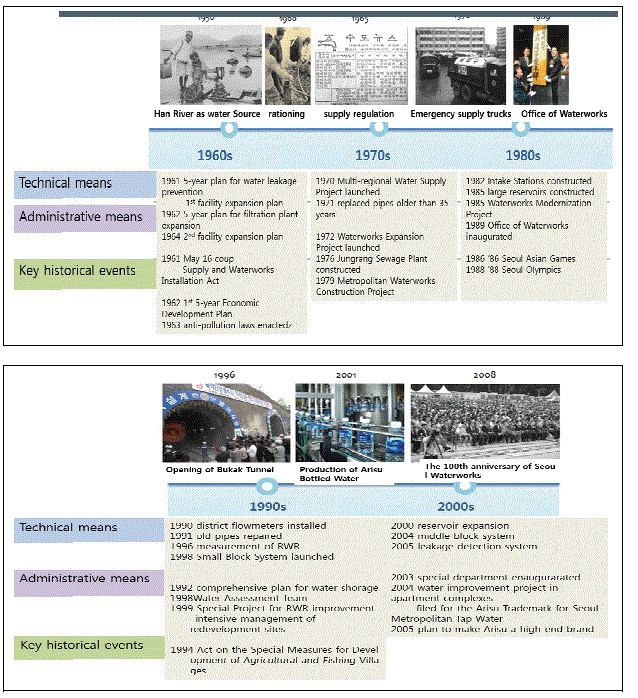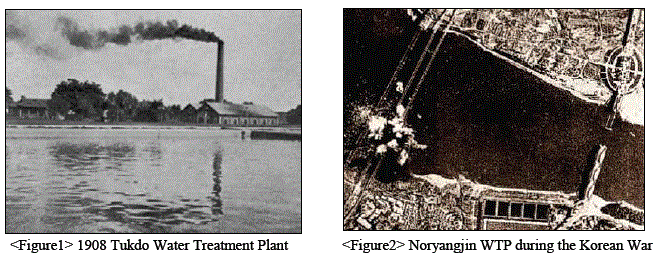Approvisionnement en eau durable de Séoul
CHALLENGE
The modern water supply in Seoul started in 1908. However, over the course of Korean War after the Japanese colonial period, most of the waterworks in Seoul was severely damaged or destroyed. After the ceasefire in 1954 for the subsequent five years, restoration project of waterworks was launched with the help of UN aids and state funds. During the 1960~70s, demand for water increased exponentially with the drivers such as fast urbanization and industrialization following the five-year economic development plan of Korea. At this point, necessity of expanding water facilities became evident.
Since the amount of water supply in Seoul at that time was insufficient, majority of citizens had to suffer a shortage of drinking water. In particular, extra administrative support was needed in vulnerable regions with lower water pressure such as highlands and extremity of the water supply line. Under these circumstances Seoul Metropolitan Government sought to secure funds through foreignaids, issuing municipal bonds and state subsidies. This effort allowed a full commitment in investing on water production facilities along with water supplying facilities and auxiliary water treatment plants.
Thanks to the steady expansion of production facilities and the slowing of population growth, water supply began to stabilize. By 1988, the service rate reached 98.8%, risen from 59.8% in 1960. As for the unstable supply on hillsides, 122 pressure booster stations were built by 1989 to mitigate the weak water pressure, along with the installation of 11 major water reservoirs completed during the three years from 1985 to 1987. Owing to such investments, the water storage capacity as increased to 648,000 m³, doubling the previous capacity.
Thanks to the large facility investments and extra support in underserved areas, the service rate in Seoul reached 99% in 1989. Following the establishment of the groundwork for reliable supply system, there was a transition in the policy agenda for waterworks, to "improvement of waterworks management via control of water quality and increase of revenued water rate(RWR).“ RWR is an indicator to measure the percentage of billed water as a share of net water produced. Higher RWR means reduced tap water loss, positively affecting financial viability of water utilities by increasing water sales and cutting unnecessary operating costs. As more citizens began to consider the quality of tap water rather than its quantity, technological and administrative means were devised to address these demands.
SOLUTION
-
Construction of reservoirs for balanced water pressure
-
Replacement of old pipes
-
Leakage monitoring via small-scale block system and measurement of minimum night flow
-
Leakage surveillance
-
Prioritized management of regions with pressurized water supply
-
Establishment of GIS with database on locations and materials of pipes
-
Inauguration of a special organization for the RWR improvement project.
-
Meticulous evaluation scheme for institutional performance based on RWR
-
Detection of fraudulent activity such as faulty metering and illegal connections

In the past, pressure boosting was the method of choice for facilitating water supply to highlands. However it was responsible for water hammer and leakage due to the unreliable water pressure. As a solution to this issue SMG transformed its plan for water supply to a passive delivery system, undertaking an expansion of service reservoirs that involved the construction of 104 new reservoirs (2,420,000 m3 in total). Such commitment paid off, as shown in the increased RWR from the reduced leakage and reliable supply.

TIMELINE

CONTACT
DO YOU WANT TO GET MORE INFORMATION ABOUT THIS POLICY?
DO NOT HESITATE
E-MAIL US!!
international@seoul.go.kr
Department / Contact
- Waterworks Research Institute / Choi young-june
- International Relations Division / 82-2-2133-5276 / international@seoul.go.kr
- Megacity Research Center / 82-2-2149-1418 / simrc@si.re.kr

